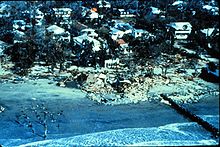Gift Quality
Rare video to have. No longer in print.
A/V Quality 8/10 This video is a very good quality transfer of VHS to DVD.

Hugo
South Carolina Recovers
This is a very rare video to have. It is a 1989 documentary produced by WIS television on hurricane Hugo which hit South Carolina September 21 - 22, 1989. WIS put this into production only about a week after Hugo came through South Carolina. This video was telecast by WIS and also sold only by special order from WIS television on VHS.This video probably the best account of Hugo slamming into the South Carolina coast the night of September 21 and working its way through South Carolina September 22, 1989. Approx run time 77 minutes (It was a 90 minute WIS special with commercials).
South Carolina
Because it was a Category 4 hurricane at landfall, the storm brought strong winds to many areas of South Carolina. In Downtown Charleston, sustained winds of 87 mph (140 km/h) were reported, along with gusts of 108 mph (174 km/h). The local National Weather Service office at Charleston International Airport recorded sustained winds of 78 mph (126 km/h) and gusts up to 97 mph (156 km/h). In Folly Beach, sustained winds of 85 mph (137 km/h) and a gust of 107 mph (172 km/h) were reported. The strongest wind gust of 120 mph (190 km/h) was recorded by the Snow Goose, which was anchored along the Sampit River near Georgetown. Extensive property damage was reported in several counties, especially in the South Carolina Lowcountry and the Grand Strand. More than 227,800 residences experienced power outages, and 85% of Bamberg and Orangeburg Counties were left without electricity, while Marion County became completely void of electrical services.[23] Extensive losses reaching $1 billion were reported at Francis Marion National Forest where about 8,800 square miles (23,000 km2) of trees were downed, enough timber to build 660,000 homes.
Storm surge and rough tides also caused extensive damage, especially in Charleston County. The highest storm surge observation was 20.2 feet (6.2 m) at Seewee Bay near McClellanville. Prior to the storm, residents of McClellanville took shelter in the cafeteria at Lincoln High School. However, storm surge flooded the room, with some people climbing up to the rafters for safety. A portion of the Ben Sawyer Bridge – linking Mount Pleasant to Sullivan's Island – collapsed due to strong winds and storm surge. On Sullivan's Island, water destroyed two or three rows of beach houses in some areas. At Isle of Palms, boats harbored at the marina were washed ashore and piled into a large heap. Losses at Sullivan's Island and Isle of Palms reached nearly $270 million.
Rainfall was moderate, due to the storm's fast motion, peaking at 10.28 in (261 mm) at Edisto Island. No widespread flooding was reported, though a combination of rain and strong winds resulted in significant agriculture losses. The Red Cross estimates that 3,307 single family homes were destroyed, 18,171 were inflicted major damage, and 56,580 sustained minor impact. Additionally, more than 12,600 mobile homes and 18,000 multi-family houses were either damaged or destroyed. Damage from Hurricane Hugo in South Carolina was estimated at $5.9 billion. Hugo remains the strongest and costliest hurricane in the history of the state. There were 35 deaths, two from asphyxiation, four from collapsing houses, two from falling trees, nine from fire and smoke inhalation, six from drowning, four from electrocutions, six from heart attacks, one fatal accidental self–injury during clean–up, and one from unknown cause.
Hurricane Hugo
| Category 5 major hurricane (SSHWS/NWS) | |

Hurricane Hugo near peak intensity east of the Windward Islands on September 15
|
|
| Formed | September 10, 1989 |
|---|---|
| Dissipated | September 25, 1989 |
| (Extratropical after September 22) | |
| Highest winds | 1-minute sustained:160 mph (260 km/h) |
| Lowest pressure | 918 mbar (hPa); 27.11 inHg |
| Fatalities | 60 total (estimated) |
| Damage | $9.47 billion (1989 USD) |
| Areas affected | Cape Verde, Lesser Antilles, Puerto Rico, Hispaniola, Turks and Caicos Islands, Bahamas, East Coast of the United States, Atlantic Canada, U.S. Virgin Islands |
| Part of the 1989 Atlantic hurricane season | |
Hurricane Hugo was a powerful Cape Verde hurricane that caused widespread damage and loss of life in Guadeloupe, Saint Croix, Puerto Rico, and the Southeast United States. It formed over the eastern Atlantic near the Cape Verde Islands on September 9, 1989. Hugo moved thousands of miles across the Atlantic, rapidly strengthening to briefly attain category 5 hurricane strength on its journey. It later crossed over Guadeloupe and St. Croix on September 17 and 18 as a category 4 hurricane. Weakening slightly more, it passed over Puerto Rico as a strong category 3 hurricane. Further weakening occurred several hours after re-emerging into the Atlantic, becoming downgraded to a category 2 hurricane. However, it re-strengthened into a category 4 hurricane before making landfall just slightly north of Charleston, on Isle of Palms on September 22 with 140 mph sustained winds (gusts to more than 160 mph). It had devolved to a remnant low near Lake Erie by the next day. As of 2016, Hurricane Hugo is the most intense tropical cyclone to strike the East Coast north of Florida since 1898.
Hurricane Hugo caused 34 fatalities (most by electrocution or drowning) in the Caribbean and 27 in South Carolina,[2] left nearly 100,000 homeless, and resulted in $9.47 billion (1989 USD) in damage overall, making it the most damaging hurricane ever recorded at the time.[3] Of this total, $7 billion was from the United States and Puerto Rico, ranking it as the costliest storm to impact the country at the time. Since 1989, however, it has been surpassed by multiple storms and now ranks as the seventeenth costliest in the United States.















